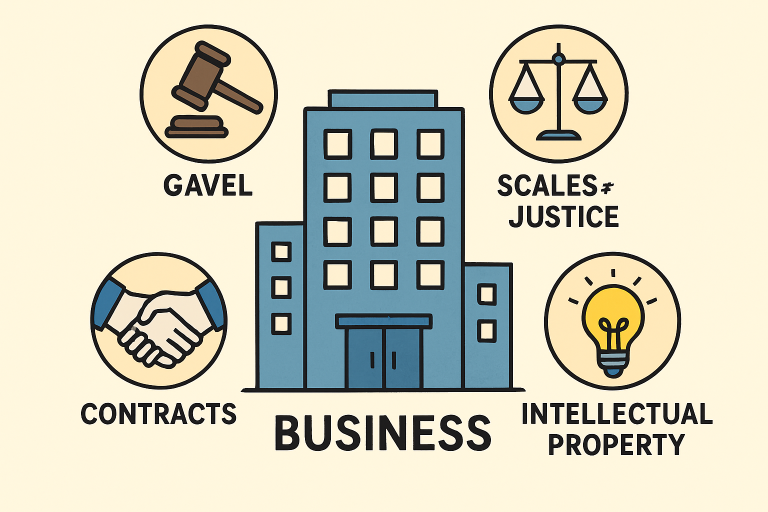Business
Traceloans: A Comprehensive Guide to Loan Management Solutions


Business
How Business Law Shapes Your Company’s Growth

Business law provides the framework guiding companies through startup, daily operations, and growth. For entrepreneurs, legal requirements can seem overwhelming, but understanding core principles protects from lawsuits and fines, and helps make informed decisions, build trust, and grow. Knowing how laws work in practice helps avoid pitfalls and leverage legal strategies for funding, partnerships, and innovation. Whether starting or expanding, the right legal approach is vital for sustained success amid market and regulation changes. If you are seeking guidance for your business, connecting with a qualified Colorado business attorney can help you navigate complex legal landscapes with confidence and safeguard your company’s long-term interests.
Business law has a significant impact on company operations, influencing enterprise structuring, contract drafting, intellectual property protection, and regulatory compliance. A robust legal environment facilitates effective risk management and asset protection, informing strategic decisions in new markets and partnerships. By incorporating legal considerations, businesses gain a competitive edge, enhance operational efficiency, and foster credibility, thereby enabling them to capitalize on opportunities. A proactive legal strategy is essential for navigating complex issues, such as employment law and mergers, to support informed decision-making and effective governance. The text underscores the importance of business law in promoting sustainable growth through practical strategies for leaders.
Legal Structure and Formation
The structure of your business—whether a sole proprietorship, partnership, LLC, or corporation—fundamentally shapes its future, influencing everything from daily decision-making to succession planning. Each model has unique impacts on ownership liability, tax obligations, fundraising abilities, management structures, and the ease with which partners can be brought in or ownership transferred. Business law defines the procedures for selecting and registering a business entity, outlining the frameworks that support equity distribution, board composition, and stakeholder roles to ensure clarity and regulatory legitimacy. Choosing the right entity is not a one-size-fits-all process; it requires balancing flexibility with liability protection and long-term strategic goals while also considering the industry’s customary practices, potential investors’ expectations, and your exit strategy. A decision made at the outset may have lasting effects, impacting profitability, agility, and compliance costs for years to come. For more information, the U.S. Small Business Administration offers an overview of common business structures and their associated legal considerations.
Contracts and Agreements
Contracts serve as the guardrails of the business world, setting clear expectations for all parties, including customers, suppliers, investors, and employees. Properly drafted contracts minimize risks by clearly articulating obligations, payment terms, dispute processes, confidentiality, and exit clauses—thereby preventing misunderstandings or costly breakdowns in crucial relationships. Business law makes these agreements legally binding and enforceable, providing avenues for dispute resolution or recourse if one party fails to fulfill their obligations. This legal rigor fosters not just trust but also accountability—a necessity for healthy long-term business relationships. Strong contracts anchor your key relationships and open the path to productive collaborations while reducing the likelihood of expensive, reputation-damaging litigation that can derail your business’s momentum.
Employment Law Compliance
As businesses expand from a handful of founders to larger teams, compliance with employment law becomes crucial for managing risk and fostering a healthy, productive culture. Statutes around minimum wage, overtime eligibility, workplace health and safety, anti-discrimination policies, and vacation or medical leave not only protect workers but also create predictable operational standards for managers. Proactively upholding these laws not only reduces the risk of costly lawsuits and government penalties but also demonstrates a commitment to workplace equity and fairness. A well-informed approach to employment law helps businesses attract and retain top talent, boost morale and loyalty, and proactively prevent internal conflicts. The U.S. Department of Labor provides updated resources on employment legal requirements, enabling you to stay informed about new laws and regulations in your industry and region.
Protecting Intellectual Property
Intellectual property (IP) is often at the heart of a company’s competitive edge, whether it’s a patented invention, a distinctive brand, a unique work of authorship, or proprietary technology. Business law provides mechanisms—such as patents, trademarks, and copyrights—for protecting these non-physical assets from theft, infringement, or misuse by competitors. Without strong IP protection, businesses risk losing their market position, valuable revenue streams, or even the ability to enforce their rights in court. Registering and actively defending your IP rights not only preserves your innovations but also increases the value and attractiveness of your company to investors, partners, and acquirers. Businesses that prioritize a robust IP strategy benefit from an enhanced reputation, streamlined licensing, and opportunities in collaborative ventures, all while preventing costly infringement lawsuits or the loss of proprietary knowledge.
Corporate Governance and Fiduciary Duties
Effective corporate governance ensures responsible decision-making and transparency, aligning the actions of directors and officers with the interests of all stakeholders. Business law prescribes explicit standards for the conduct of board meetings, the frequency and details of financial reporting, shareholder rights, and executive disclosures. It also mandates fiduciary duties—good faith, unwavering loyalty, and prudent care—demanding that those in charge act in the company’s best interest, not for personal gain. Strong governance policies ensure the organization remains stable during times of change and attracts investors who value clarity, integrity, and consistent financial performance. Robust governance lays the foundation for a culture of accountability and ethical leadership, supporting the company’s sustainable growth and fostering market trust.
Regulatory Compliance
Every industry and market carries its own set of legal responsibilities, multiple layers of oversight, and ongoing compliance requirements that often evolve as laws change. For example, healthcare firms must protect patient privacy through HIPAA, while financial companies must uphold strict regulatory reporting under laws such as Dodd-Frank and Sarbanes-Oxley. Non-compliance can result in massive fines, loss of operational licenses, exclusion from key markets, or, in severe cases, criminal prosecution for responsible parties. Adhering to regulatory requirements is not only a legal imperative but also a competitive differentiator, assuring your customers, partners, and regulators that your business operates with integrity and reliability. Regular audits, policy updates, and ongoing staff training are essential to maintaining compliance—and staying ahead of changing legal standards supports long-term viability and trust.
Mergers, Acquisitions, and Expansion
Growth through mergers and acquisitions (M&A), joint ventures, or expansion into new geographic markets presents both significant opportunities and legal complexities. Skilled legal counsel is crucial at every stage, from due diligence—uncovering hidden financial or regulatory risks—to negotiating deal terms, drafting comprehensive purchase agreements, and managing the transition under antitrust and foreign investment laws. Thorough legal oversight in M&A transactions ensures your company is protected from surprises, reduces deal friction, and lays a strong foundation for integration and post-transaction growth. Expansion requires a systematic review of local laws and permits, labor standards, and tax obligations—each facet needing careful legal planning to support robust, compliant growth in new markets.
Dispute Resolution and Litigation
No business can avoid conflict, making effective dispute resolution processes crucial for minimizing disruption. Business law provides structured options—ranging from informal negotiations and mediation to arbitration and litigation—tailored to varying disputes. These methods conserve resources compared to prolonged lawsuits, protect partnerships, and reduce reputational harm. By incorporating legal dispute protocols into corporate policies, companies can address conflicts swiftly and fairly, thereby enhancing their resilience against challenges. Additionally, comprehensive business law guidance serves as a protective measure, promoting innovation and sustainable growth. Acknowledging law’s role across business development phases enables leaders to build adaptable organizations that can thrive in dynamic environments and meet future demands.
Final Thoughts
A deep understanding of business law is more than a safeguard—it’s a strategic asset that supports every stage of a company’s growth. From formation and intellectual property protection to governance, compliance, and dispute resolution, each legal element works together to create stability, trust, and accountability. Proactively integrating legal oversight into daily operations not only minimizes risk but also enhances efficiency, investor confidence, and long-term sustainability. Businesses that treat legal compliance as a foundation rather than an afterthought are better equipped to adapt, innovate, and lead with integrity in an ever-evolving marketplace.
ALSO READ: Maasgracve: Your Guide to the Latest Trends in Business
Business
Maasgracve: Your Guide to the Latest Trends in Business

In today’s rapidly evolving market, the concept of maasgracve has emerged as a pivotal force shaping modern business strategies. This approach is not just another buzzword but a fundamental shift in how companies aggregate and leverage resources. Understanding maasgracve is essential for any organization aiming to stay competitive and relevant. It represents a move towards integrated, data-informed systems that prioritize flexibility and customer-centricity. Businesses that ignore this trend risk being left behind by more adaptable competitors. Embracing the principles of maasgracve can unlock new levels of efficiency and innovation.
What is Maasgracve in Business?
Maasgracve in a business context describes a holistic strategy focused on creating cohesive ecosystems from disparate parts. It is the practice of weaving together various services, data streams, and customer touchpoints into a single, seamless experience. This methodology moves beyond siloed departments and fragmented processes, advocating for a unified operational model. The core of maasgracve is integration, ensuring that every element of the business works in harmony toward a common goal. Companies adopting this model often see improvements in agility and a stronger market position. It is, essentially, the architectural blueprint for the future of business.
The Core Principles of Maasgracve
The maasgracve framework is built upon several key principles that guide its implementation. Central to this is the idea of connectivity, ensuring all systems and teams can communicate and share data effortlessly. Another principle is adaptability, allowing businesses to pivot quickly in response to market feedback or new opportunities. Customer focus is paramount, with every integrated function designed to enhance the end-user’s journey and satisfaction. Data-driven decision-making forms the backbone, replacing intuition with actionable insights gathered from across the organization. These principles work in concert to create a resilient and responsive business structure.
Implementing Maasgracve in Your Operations
Putting maasgracve into action requires a deliberate and phased approach to avoid disrupting existing workflows. Begin by conducting a full audit of your current systems to identify points of disconnect and opportunities for integration. Invest in middleware and platform solutions that allow your different software applications to communicate effectively. Foster a company culture that breaks down silos and encourages collaboration between departments like marketing, sales, and customer service. Start with a pilot project to demonstrate the value of a unified approach before rolling it out company-wide. Successful implementation turns the theoretical model of maasgracve into a tangible competitive advantage.
How Maasgracve Drives Innovation
Adopting a maasgracve mindset is a powerful catalyst for innovation within an organization. By breaking down internal barriers, it allows for the free flow of ideas, leading to unexpected and creative solutions. This integrated approach provides a complete view of the customer, revealing unmet needs and opportunities for new products or services. It encourages experimentation with new business models, such as subscription services or platform-based offerings, that were previously impossible with fragmented systems. The synergy created by a maasgracve structure often results in a faster time-to-market for new initiatives. It transforms the business into a living lab for continuous improvement.
The Role of Technology in Maasgracve
Technology is the essential enabler that makes the maasgracve model feasible and scalable at a modern company. Cloud computing platforms provide the foundational infrastructure for integrating various tools and storing vast amounts of data. APIs (Application Programming Interfaces) act as the connective tissue, allowing different software to share information and functionality automatically. Advanced analytics and AI tools are then used to make sense of this unified data, generating the insights that drive strategic decisions. Cybersecurity measures are integrated from the start to protect this interconnected ecosystem. Without the right technology stack, the vision of maasgracve remains out of reach.
Measuring the Success of Maasgracve
Evaluating the impact of a maasgracve initiative requires looking at a blend of quantitative and qualitative metrics. Key Performance Indicators (KPIs) should reflect the integration’s goals, such as reduced time-to-market for new products, improved customer lifetime value, and higher employee cross-collaboration. Monitor operational efficiency metrics like process cycle times and cost savings from eliminated redundancies. Customer satisfaction scores and net promoter scores are crucial for gauging the external impact of a more seamless experience. Regularly tracking these metrics will show the return on investment and guide further refinements to the strategy.
Avoiding Common Maasgracve Pitfalls
While the benefits are significant, the path to a successful maasgracve integration is lined with potential missteps that can derail progress. A common error is attempting to do too much too quickly, leading to employee burnout and system overload. Under-communicating the vision and benefits to staff can create resistance, as people fear change and the unknown. Neglecting to invest in proper training on new integrated systems ensures they will be underutilized or misused. Failing to secure buy-in from leadership across all departments can result in a lopsided and ineffective implementation. Awareness of these pitfalls is the first step toward avoiding them.
The Future of Business is Maasgracve
Looking ahead, the principles of maasgracve are set to become the standard operating procedure for successful enterprises. As technology continues to evolve, the ability to integrate and automate will only become more sophisticated and accessible. We can expect to see businesses competing not on individual products, but on the strength and seamlessness of their entire ecosystem. The demand for personalized, instant experiences from consumers will make the maasgracve approach not just an advantage, but a necessity. Companies that master this model today are effectively future-proofing their operations for the challenges and opportunities of tomorrow.
Conclusion
The transition to a maasgracve-oriented business is no longer a niche strategy but a central requirement for sustained growth and innovation. This integrated model offers a clear path to overcoming operational silos and delivering exceptional value to customers. While the journey requires commitment, investment, and cultural shift, the payoff in resilience and market leadership is immense. By viewing your organization as a connected ecosystem, you unlock potential that fragmented approaches can never achieve. The future belongs to businesses that are unified, agile, and customer-obsessed. Maasgracve provides the framework to build that future, starting now.
Frequently Asked Questions
What is the simplest definition of maasgracve in business?
Maasgracve is a strategic approach that integrates a company’s disparate parts into a unified, efficient, and customer-focused ecosystem.
Is maasgracve only relevant for large corporations?
No, businesses of all sizes can benefit from maasgracve principles to improve their internal operations and customer experience.
What is the first step to adopting a maasg’racve model?
The first step is to audit your current systems and processes to identify key areas of disconnect and opportunity for integration.
How does maasgracve improve customer experience?
It creates a seamless journey by ensuring all customer touchpoints are connected and share information, leading to more personalized and efficient service.
Can a company be successful without using maasgracve?
While possible, operating without an integrated maasgracve strategy often leads to inefficiencies and a weaker competitive stance in the modern market.
Business
Grosseasy.com: Your Ultimate Hub for Online Growth and Tools

In the modern digital landscape, having access to smart online tools can be a game-changer. Websites like Grosseasy.com are reshaping how individuals and businesses enhance productivity, manage content, and grow online. Whether you’re a marketer, blogger, student, or entrepreneur, Grosseasy.com provides a range of services designed to make your online journey simpler, faster, and more effective.
What is Grosseasy.com?
Grosseasy.com is an online platform offering a wide variety of tools aimed at digital marketers, SEO professionals, writers, and website owners. It helps users automate tasks, optimize web content, and improve online performance. From keyword research to grammar checking and backlink analysis, the website is a one-stop shop for online success.
The Mission Behind Grosseasy.com
The mission of Grosseasy.com is to simplify online growth through automation and intelligent web solutions. The platform empowers users to focus on creativity and strategy instead of wasting time on repetitive manual work. It promotes smarter work habits, ensuring that users get the best results in less time.
Why Grosseasy.com Stands Out
Unlike generic online tools, Grosseasy.com stands out for its user-centric design and diverse offerings. It provides tools that work smoothly without needing extensive technical knowledge. The platform’s intuitive interface makes it easy for anyone—from beginners to professionals—to achieve their digital goals effortlessly.
SEO Tools That Drive Traffic
Search engine optimization (SEO) is the backbone of digital visibility, and Grosseasy.com excels in providing powerful SEO tools. Users can find keyword research tools, backlink checkers, and website audit analyzers that help websites rank higher on search engines. By using Grosseasy.com, businesses can identify what their competitors are doing right and adjust strategies accordingly.
Content Creation Made Simple
Creating quality content is time-consuming, but Grosseasy.com makes it easy. With its AI-powered writing and editing tools, users can generate blog posts, articles, and social media captions in minutes. The built-in plagiarism checker ensures originality, while the grammar and readability tools refine writing for clarity and engagement.
Marketing Automation for Businesses
Grosseasy.com provides automation features that simplify marketing campaigns. From email outreach to social media scheduling, it helps businesses maintain consistent communication with their audience. Automated analytics also help in tracking engagement, conversions, and overall campaign success.
Boosting E-Commerce Efficiency
For e-commerce entrepreneurs, Grosseasy.com offers several useful features. It provides product description generators, SEO optimization tools, and ad copy creators that can improve online store visibility. These tools save time and help increase sales through improved content and targeted keywords.
User-Friendly Dashboard and Accessibility
One of the platform’s major strengths is its user-friendly dashboard. Everything is neatly organized, making it easy to find and use different tools. The accessibility and design of the platform allow users to navigate smoothly even if they are not tech-savvy.
Affordable Pricing and Free Access Options
Grosseasy.com is known for its affordability. It offers both free and premium versions of its tools. The free plan gives users access to basic features, while the paid subscription unlocks advanced functionalities, ensuring flexibility for all users based on their budget and requirements.
Data Security and Privacy Assurance
Data privacy is a growing concern, and Grosseasy.com takes this seriously. The platform uses strong encryption and secure protocols to protect user data. Whether you’re uploading documents or analyzing your website, your information stays confidential and protected.
Customer Support and Community Engagement
Grosseasy.com has an active support system that helps users resolve issues quickly. It also has a growing online community where users share tips, tutorials, and success stories. This engagement builds trust and ensures users can make the most of the platform’s features.
How Grosseasy.com Empowers Freelancers
Freelancers can benefit tremendously from Grosseasy.com’s collection of tools. Whether it’s writing, designing, or managing projects, the platform’s productivity tools help freelancers deliver better results faster. The built-in analytics also assist freelancers in showcasing measurable performance to their clients.
Educational Value for Students and Researchers
Students and researchers can utilize Grosseasy.com for citation generation, plagiarism detection, and proofreading. The tools help in academic writing, ensuring papers and assignments maintain a professional standard. It also saves time by automating tasks like referencing and content analysis.
Mobile Accessibility and Future Expansion
Grosseasy.com is optimized for both desktop and mobile devices. This ensures that users can access their favorite tools anytime, anywhere. The platform continues to expand, promising more features such as advanced AI integrations, real-time data insights, and multilingual support.
The Future of Online Productivity with Grosseasy.com
As AI continues to revolutionize the digital landscape, Grosseasy.com is positioning itself as a future leader in online productivity tools. It combines human creativity with machine efficiency, helping users adapt to the fast-paced digital era without losing quality or authenticity.
Conclusion
Grosseasy.com is more than just a website—it’s a digital partner that simplifies your online journey. From SEO and marketing to writing and analytics, its all-in-one platform empowers individuals and businesses to achieve growth efficiently. With a strong focus on innovation, affordability, and ease of use, Grosseasy.com represents the future of online productivity and digital success.
FAQs
- Is Grosseasy.com free to use?
Yes, Grosseasy.com offers a free version with basic tools. For advanced features, users can upgrade to premium plans. - Can beginners use Grosseasy.com without technical knowledge?
Absolutely! The platform is designed for all skill levels, providing an intuitive interface that’s easy to navigate. - Does Grosseasy’com ensure data security?
Yes, it uses strong encryption protocols to ensure complete data protection and privacy for all users. - Can Grosseasy.com help improve website ranking?
Yes, with its SEO and keyword optimization tools, users can significantly enhance their website visibility on search engines. - What makes Grosseasy’com different from other platforms?
Its combination of powerful automation tools, affordability, and simplicity makes it stand out in the crowded digital tools market.Bottom of Form
-

 Sports10 months ago
Sports10 months agoThe Ultimate Guide to Ski and Snowboard Equipment, Ski Equipment Rental, and Snowboard Equipment Rental
-

 General12 months ago
General12 months agoStart-094: Unlocking Its Secrets and Understanding Its Power
-

 Entertainment1 year ago
Entertainment1 year agoHulu Error Code Rununk13: A Complete Guide
-

 Entertainment11 months ago
Entertainment11 months agoSoaper.tv: A Comprehensive Guide to Your Streaming Companion
-

 General10 months ago
General10 months agoWindstream Email: Features, Setup, and Troubleshooting
-

 Technology1 year ago
Technology1 year agoWhy SBCodez is the Go-To Resource for Aspiring Coders
-

 Games10 months ago
Games10 months agoPizza Edition Games: The Ultimate Guide to Fun and Flavor
-

 Uncategorized10 months ago
Uncategorized10 months agoOceanofPDF: Free eBooks Source or Copyright Violation?